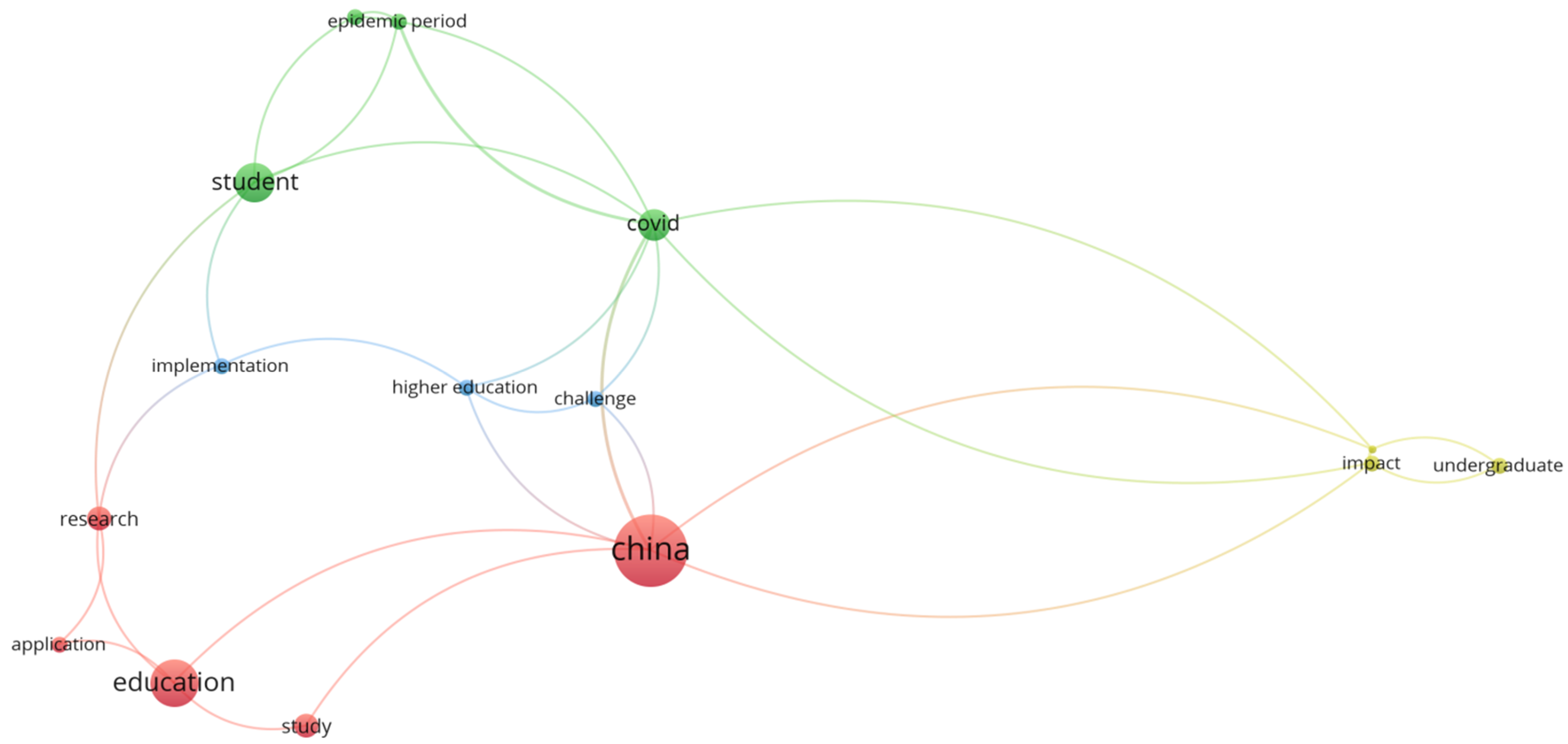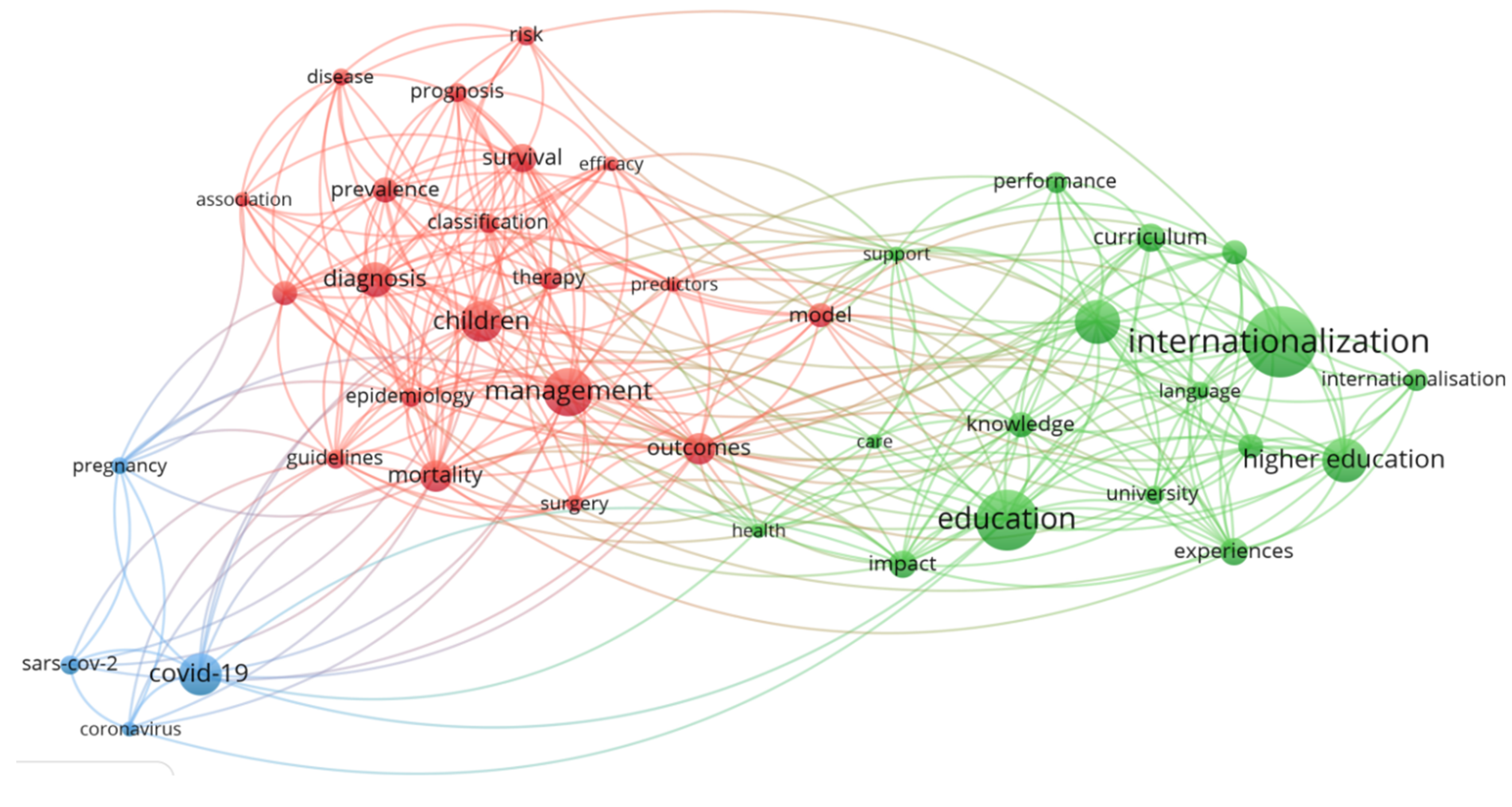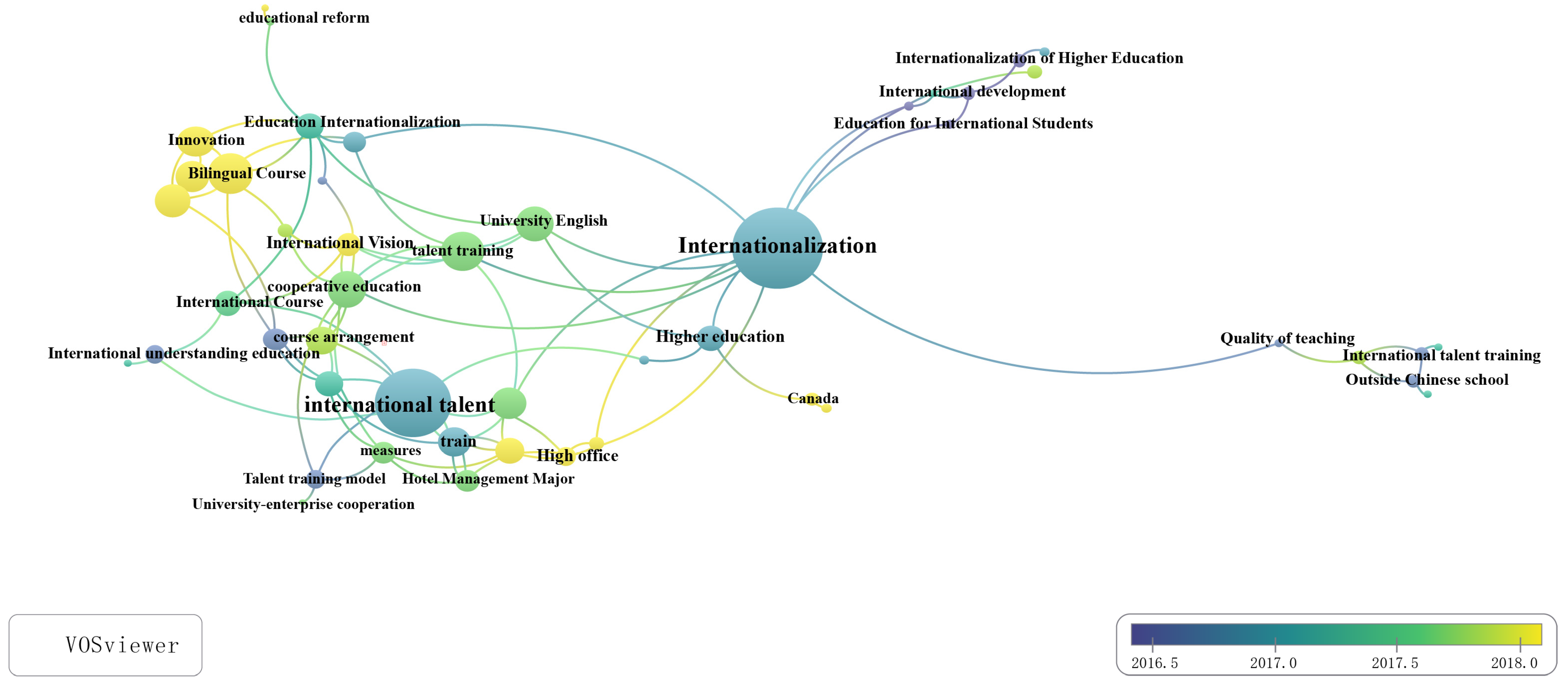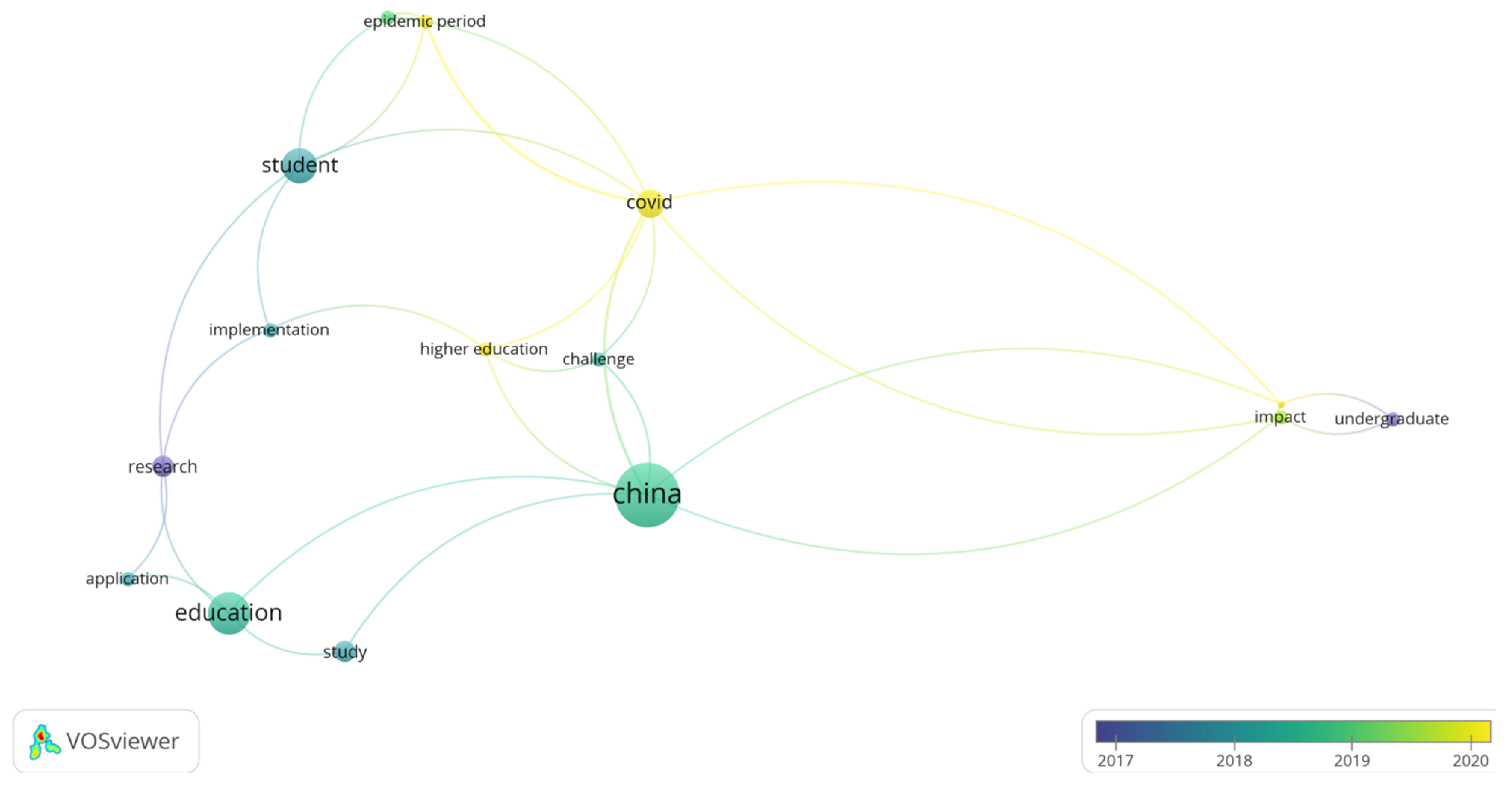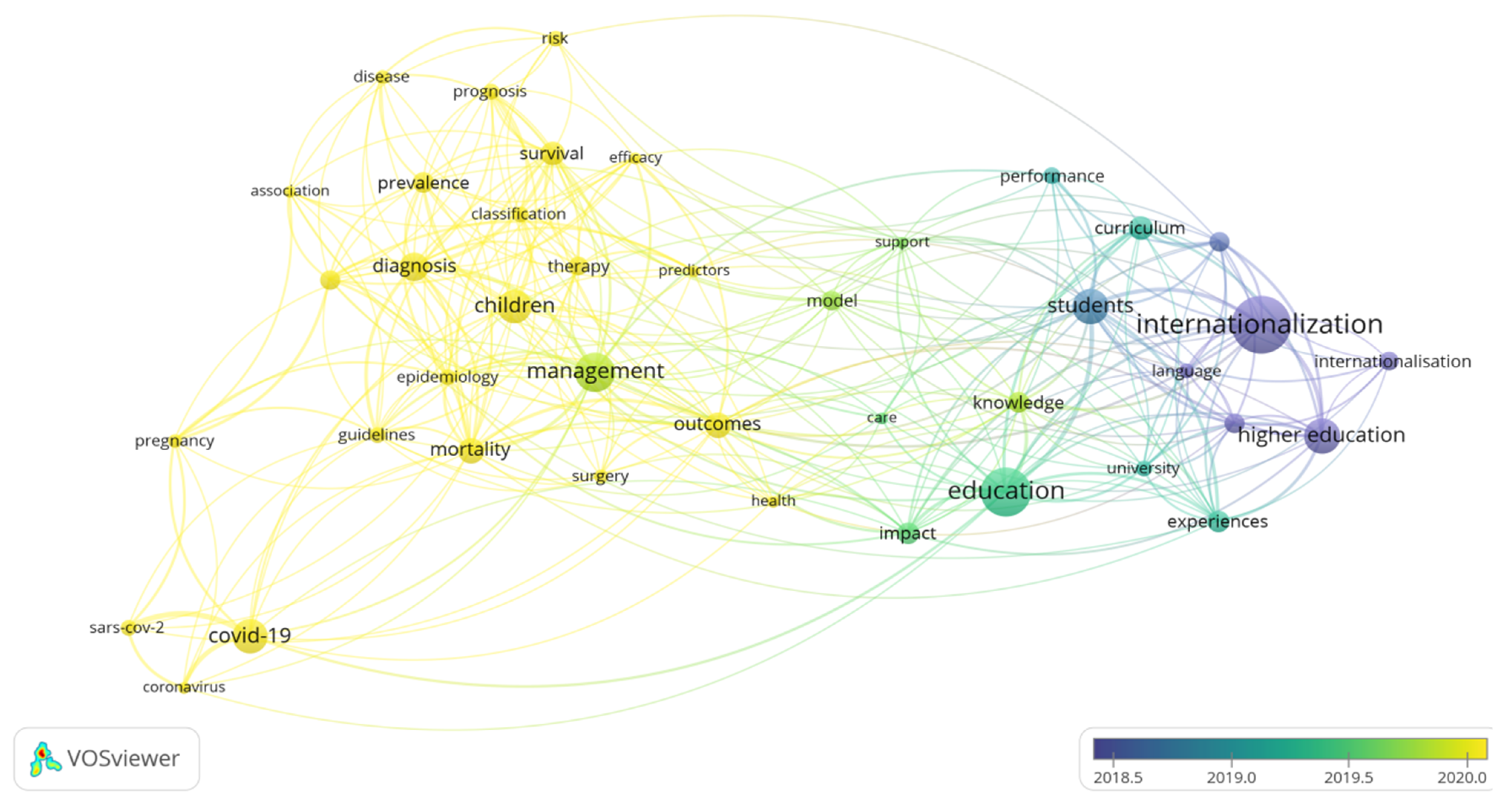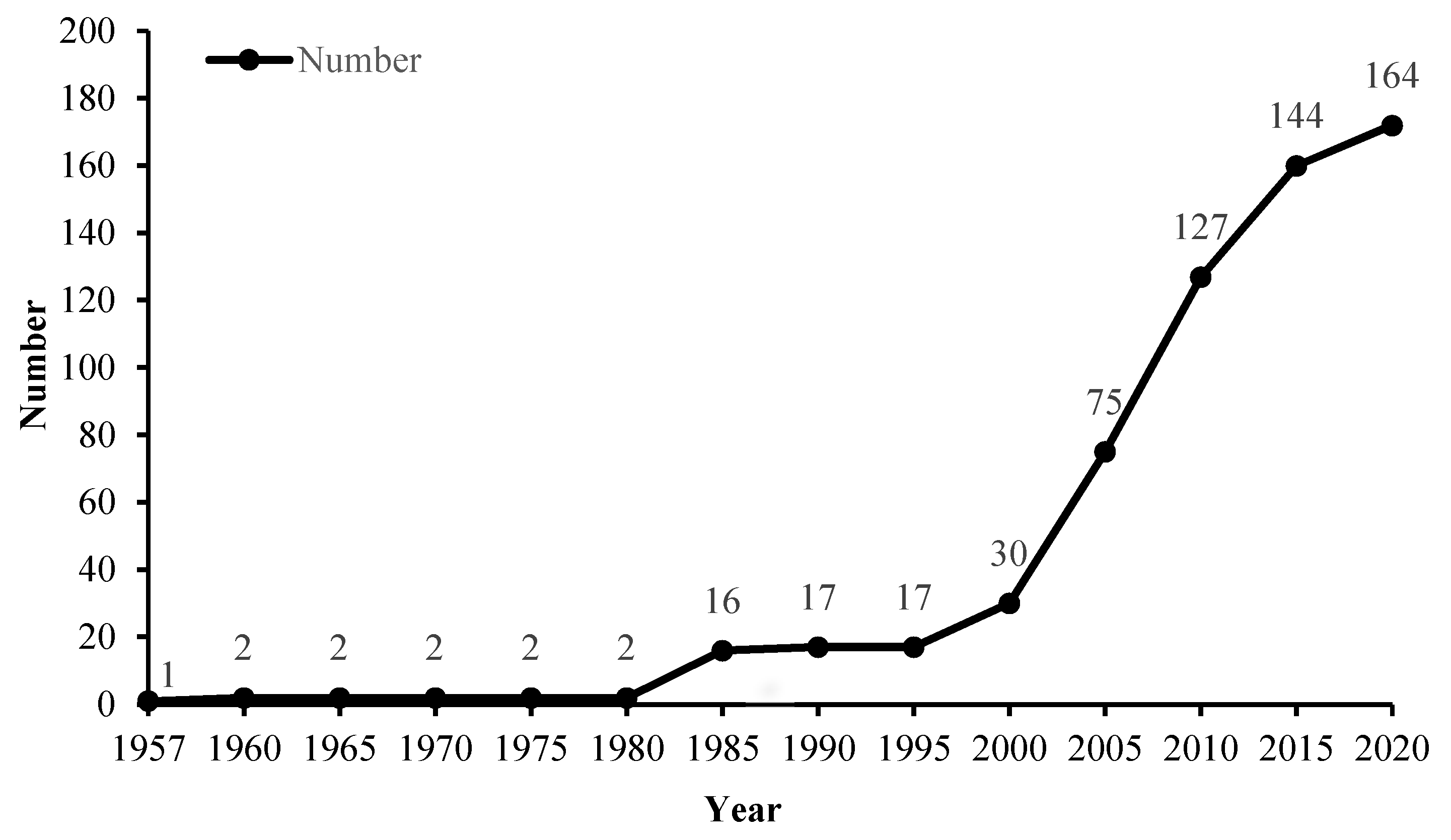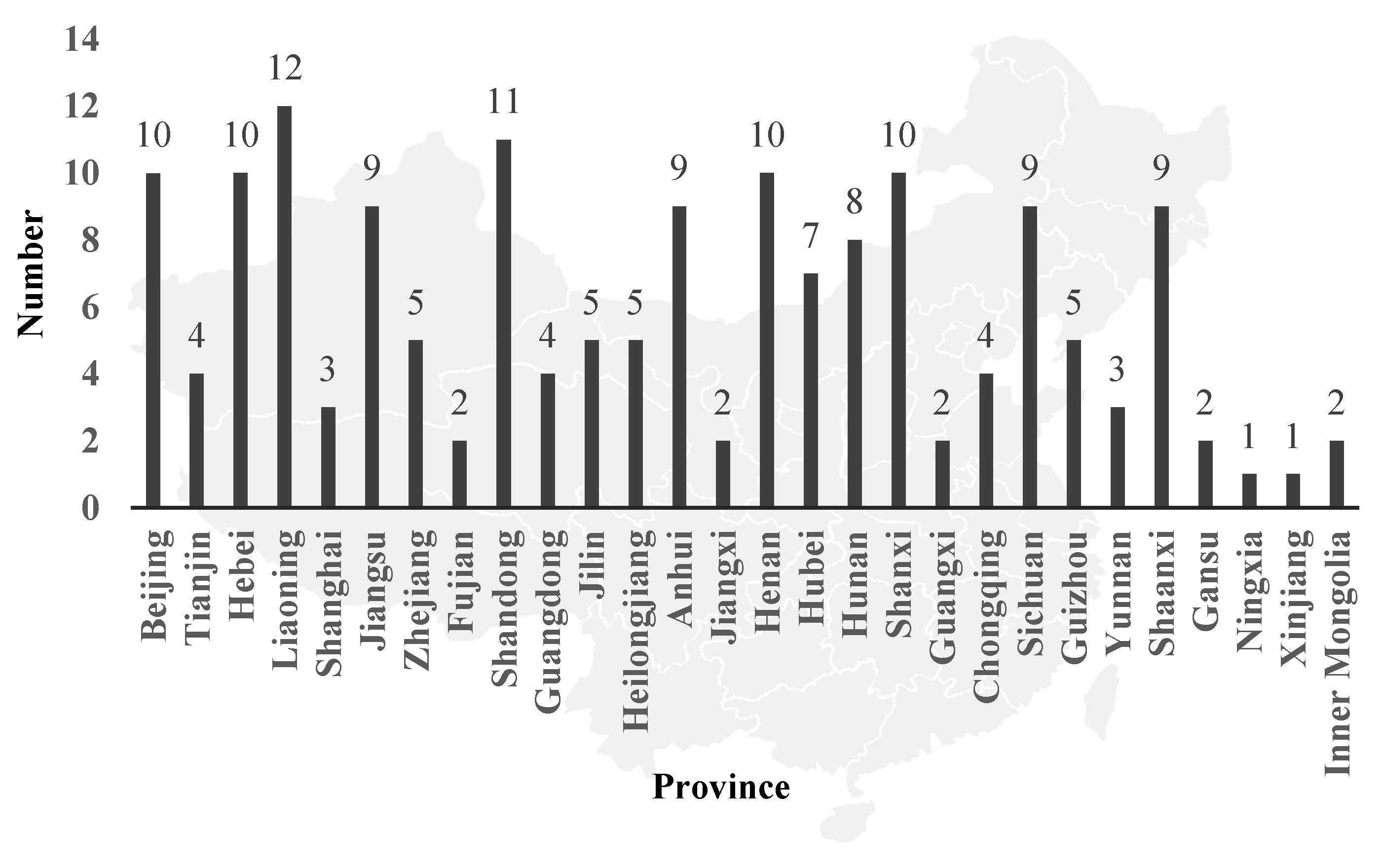1. Introduction
Course internationalization, fundamentally speaking, requires that teachers have an open mind, schools should have an international awareness, and students should have a broad vision. Course internationalization integrates international and cross-cultural thinking into course objectives and teaching. This involves content reform, curriculum design, teaching mode, and other aspects. Regarding the various types of course internationalization, this research specifically refers to the compulsory international courses for undergraduates majoring in safety engineering taught by foreign teachers. This research explored methods to further improve the effectiveness, quality, and sustainable development of the international safety engineering courses at CUMTB.
International courses have been popularized in Chinese universities. It can not only teach professional knowledge but also bring students international frontier research and international teaching mode. Universities are constantly paying attention to the course effect while students are acquiring knowledge. There have been many kinds of researches on internationalization, talents, and higher education in the field of international courses [
1,
2,
3,
4]. However, the internationalization of curriculum in specific disciplines needs to be further explored [
5,
6,
7]. Therefore, this research extracted the influencing factors of international courses for in-depth research based on the previous study. We have also researched ways to continuously improve the course effect. This can both contribute to the study of international courses in safety disciplines and the study of influencing factors of course effect.
In this research, three methods, co-occurrence analysis, statistical analysis, and questionnaire survey, were used to explore the effect of improving safety engineering international course in CUMTB. This research included three sections. Firstly, the research background, topics, and trends of the international course were introduced. Secondly, the universities with safety engineering major in mainland China and their international courses were studied. Finally, the international courses of safety engineering in CUMTB were investigated, and future research directions were proposed.
2. Literature Research on International Courses
This section analyzes the research background, topics, and trends of the international course by the method of keyword co-occurrence analysis. According to the literature analysis, the influencing factors are extracted and classified as the basis of the questionnaire design.
Keyword co-occurrence analysis is to cluster literature with the same keywords and show their relationships through network structure [
8]. Explaining the keywords’ co-occurrence as their associations and representational signals, and analyzing these relationships in complex network paradigms, can lead to new perspectives [
9]. This research used three search strings, including: “international course,” “internationalization,” and “curriculum,” to explore databases. We selected all the literature databases purchased by CUMTB to obtain more comprehensive literature. The databases include Chinese and other countries’ databases. The former includes CNKI, Wanfang Data, Chaoxing Database, and Chinese Social Science citation database. The latter consist of Web of Science, Engineering Village, ScienceDirect, and IET Electronic Library. Journal papers, dissertations, books, and conference papers in Chinese and English are all included in the search scope.
Given the research’s timeliness, this research collects Chinese and English literature published in 2016–2020 related to international courses. In total, 2737 Chinese studies were selected and analyzed, and 549 English articles were analyzed. The results are shown in
Figure 1,
Figure 2,
Figure 3,
Figure 4,
Figure 5,
Figure 6.
As shown in
Figure 1 and
Figure 2, research on international courses in China focuses on international talent, education internationalization, course innovation, and higher education [
10,
11,
12].
The research topics can also be specific to college English, bilingual courses, finance, and other aspects or disciplines [
13,
14,
15]. The Chinese characteristics of the “Belt and Road Initiative” (B and R) also occupy a certain proportion of international course research [
16]. In addition, COVID-19 appears in the research topics. The COVID-19 pandemic in 2019 has likely accelerated the development of international online courses [
17]. Among all the research topics related to international courses, higher education is closely related to internationalization. Course internationalization has become a development trend for Chinese universities.
Figure 3 shows that international course research topics in English literature (except work done by Chinese scholars) mainly focus on internationalization, higher education, language, university, and COVID-19 [
18,
19,
20,
21,
22,
23]. Research topics can also focus on a particular discipline, such as international geography courses, civil engineering, and international psychology [
24,
25,
26,
27,
28,
29,
30]. In addition, there is also research on the development trend of international curriculum [
31]. COVID-19 also appears in the research topics, which may be due to the pandemic promoting online teaching development [
32,
33,
34,
35].
Concerning research trends in international curricula, it can be seen from
Figure 4 and
Figure 5 that in the past five years, research on international courses in China has gradually developed from internationalization, education internationalization, and international talent training research to trends focusing on specific disciplines with Chinese characteristics. These currently include basic education, core qualities, teaching reform, innovation, bilingual curricula, traditional culture, and the “B and R” initiative. Research on international courses with innovative characteristics has become a trend in China. In addition, it can be seen from
Figure 6 that other countries’ research trends are also gradually focusing on specific aspects or disciplines, such as higher education, language, disease, and risk, with a higher degree of integration with medical disciplines.
Although the research topics of international courses in China and other countries are related to higher education’s internationalization, there are also differences. China pays more attention to talent training, higher education, and curriculum innovation research. Its developmental trends have gradually grown from talent training research to characteristic discipline research. However, most other countries’ research topics are related to the internationalization of universities and higher education. Medical research is closely related to international curriculum research, and research trends have gradually focused on specific disciplines.
From the above analysis, it can be concluded that the relative research is gradually increasing due to the development of international courses. However, there are few studies focus on the safety engineering major. Based on the literature research, we grouped the influencing factors into two categories: teachers and teaching content. We specifically included the type of teacher, teaching mode, learning difficulties, teaching content, and learning purpose, etc. This is the basis for designing the questionnaire to explore the reasons behind the influencing factors. The questionnaire in the third section was designed based on “teachers,” “teaching content,” and “course effect.”
3. Safety Engineering in the Higher Education Institutions of China
This part analyzes the current situation and reasons of safety engineering major and its international courses in China through the statistics data.
3.1. Universities with Safety Engineering Major in China
Safety engineering in China has been developing since the 1950s. The number and trend of universities with safety engineering from 1957 to 2020 is shown in
Figure 7 (according to incomplete statistics). The data in
Figure 7 are from the website of China Education Online and the official websites of universities.
Although the data in
Table 1 may not be completely accurate, it can roughly describe a trend.
It is obvious that the number of universities with the safety engineering major shows a significant growth trend. Especially, the growth was rapid in 1980 and 2000 since China held a conference on science education in 1977 to fully prepare for curriculum reform. After the curriculum reform from 1981 to 1985, curriculum development tended to be standardized [
36]. The Ministry of Education established “safety engineering” as an undergraduate major in 1984 [
37]. This led to the first significant increase in the number of safety engineering majors since 1985. Then, the Ministry of Education issued 15 policy documents on higher education and 4 documents on the establishment of academic disciplines to promote the development of education in 2000 [
38]. Therefore, the number of safety engineering majors increased rapidly again after 2000.
With the expansion of the scale of the safety engineering major, the initial undergraduate education gradually developed to graduate education. In 2011, the Ministry of Education changed the names of master’s and doctoral degrees to “safety science and engineering,” which are still in use today [
39]. At present, China has established a complete education system of bachelor’s degrees, master’s degrees, doctoral degrees, and postdoctoral safety disciplines. According to statistics, universities with safety engineering are involved in many fields and industries, including defense, aviation, chemicals, petroleum, mining, civil engineering, transportation, energy, environmental, and economics.
The number of universities with safety engineering (by province) is shown in
Figure 8. Universities with safety engineering are widely distributed in Beijing, Hebei, Liaoning, Jiangsu, Shandong, Sichuan, and Henan. In contrast, there are no universities in Tibet, Qinghai, or Hainan offering this major. Among the 164 universities with safety engineering, 38 universities are located in western China, 46 in central China, and 80 in eastern China.
Hence, there are regional differences in the number of universities with safety engineering, as shown in
Figure 8. Among the 164 universities with safety engineering, 78% are located in the central and eastern regions, while only 22% are in the western regions. This distribution is related to the general distribution of universities in China, as well as the economic development, population density, and professional demands of the various regions.
To further study the reasons for the changes in the number of universities with the safety engineering major in each province, we counted the data from each province, as shown in
Table 1. These data come from the official websites of the school.
According to
Table 1, the eastern and central regions have developed the safety engineering majors earlier. The development of safety engineering in the eastern region, central region, and western region is in 1980, 1985 and 2002, respectively. It is related to some factors such as economic, policies, population, etc. From 1960 to 2000, China’s economic, industrial, and population centers of gravity have been concentrated in the central and eastern regions, especially in the east. Therefore, the demands for safety professionals are greater than those of the west region. Universities in these areas are also more likely to absorb advanced safety science concepts and train professionals to promote industrial modernization [
40]. Moreover, since 2000, with the support of new policies from the Ministry of Education, the safety engineering major in the western region has also been developed.
Therefore, the economy, policies, population, enterprises, and energy of each province will affect the development of the local safety engineering major.
3.2. International Safety Engineering Courses of Chinese Universities
According to incomplete statistics, public channels (such as course catalogs on official university websites) show that among the 164 universities with safety engineering, 20 universities have set up international courses related to safety disciplines, which account for 11.6% (see
Table 2 for details). This research argues that the actual number of universities with international courses related to safety disciplines should be far greater than the statistics in
Table 2 indicate. As some universities may not put their course offerings on their official website or other public channels, the statistics may be incomplete.
According to
Table 2, 14 of the 20 universities come from the central and eastern regions, accounting for 70%. The regional distribution of safety discipline international courses is consistent with the distribution of universities with safety engineering, which shows that regional factors also have a certain influence on international courses.
4. Methods
This part introduces the survey method for the international course of safety engineering major in CUMTB and explains the design principles of the questionnaire. Through previous literature analysis, the influencing factors were regrouped into two categories: teachers and teaching content. On the basis of being able to adopt sustainable development measures, the influencing factors and their causes are explored in greater depth from a new perspective in this section.
The questionnaire was designed based on the influencing factors summarized in the literature analysis section and then categorized into “teachers,” “teaching content,” and “course effect.” “Teachers” and “teaching content” are used to investigate the factors and reasons. “Course effect” is a separate part to comprehensively examine students’ perceptions of the effect. The questionnaire is shown in
Table 3.
This research chose Cronbach’s α reliability coefficient to reflect the validity of the questionnaire. Cronbach’s α is a commonly employed index of test reliability [
41]. The higher the α value, the more consistent, stable, and reliable the data. In addition, “Cronbach’s α based on standardized items” is a correction coefficient. It eliminates the errors based on the Cronbach’s α value and makes the results more realistic. In general, if the value of α coefficient does not exceed 0.6, it is generally considered that the internal reliability is insufficient; a value between 0.7 and 0.8 means the scale has considerable reliability; and a value between 0.8–0.9 means a high degree of internal consistency.
The questionnaire is divided into two parts, including eight questions. According to the SPSS analysis, Cronbach’s α for the first part is 0.769, and “Cronbach’s α based on standardized items” is 0.782. The two corresponding values for the second part are both 0.769. All the values are higher than 0.7, indicating that the questionnaire has considerable credibility.
In order to ensure the validity of the questionnaire, this research uses a comprehensive survey method to investigate all undergraduates majoring in safety engineering in CUMTB in 2018 and 2019. At CUMTB, students are enrolled in the international courses during their sophomore year. The total number of undergraduates majoring in safety engineering in CUMTB in 2018 and 2019 separately is 129 and 124.
The survey is divided into two stages: pre-course and after-course. In the first stage, 124 CUMTB safety engineering undergraduates were surveyed before the course in 2019. A total of 122 questionnaires were collected, accounting for 98.4% of the total questionnaires. After invalid sample processing, a total of 122 valid questionnaires were collected, accounting for 100% of the total.
In the second stage, questionnaires were distributed to 253 CUMTB safety engineering undergraduates after the course in 2018 and 2019. Of those distributed, 173 questionnaires were recovered, accounting for 68.4% of the total. After invalid sample processing, 171 valid questionnaires were collected, accounting for 98.8% of the total questionnaires.
It should be noted that the international courses at CUMTB started in 2018. Due to the hasty preparation concerning the first international course class, no questionnaire survey was conducted for the students before the course in 2018. The teaching model in 2018 was classroom teaching, and in 2019, it was changed to online due to the spread of COVID-19.
5. Results and Analysis
This section investigates the international courses for CUMTB’s safety engineering majors in 2018 and 2019 and studies international courses’ effects and problems. The investigation results and analysis are presented.
The investigation and analysis are carried out in three aspects: teachers, teaching content, and course effect.
5.1. Teachers
Questions 1 and 5 investigated students’ expectations for teachers before the international course and their opinions on the teachers after the course, respectively. The results are shown in
Table 4. The types of teachers employed for international courses in 2018 and 2019 are shown in
Table 5.
The results of Question 1 (from high to low) are: university teachers from abroad, such as Europe and America (37.7%); ethnic Chinese university teachers (30.3%); university teachers with enterprise backgrounds (16.4%); researchers from scientific research institutions (5.7%); enterprise experts (5.7%); and editors of journals (4.1%). This is similar to Fan’s research findings on international courses [
42].
In the first stage of the survey, 84.4% of the students chose university teachers before the course. There was no obvious difference between ethnic Chinese university teachers and university teachers from abroad.
According to the results of Question 5, university teachers are still the primary choice after the course. Although we have hired teachers with enterprise backgrounds and other types of teachers in these two international courses, students still prefer university teachers. In addition, the number of enterprise experts, journal editors, and researchers has not changed greatly. However, the number and proportion of those choosing ethnic Chinese teachers after the courses increased significantly. This indicates that students’ recognition of ethnic Chinese teachers has increased. Further research has been carried out through Questions 7 and 8 to determine the reasons for this change. The results are shown in
Table 6 and
Table 7.
The course learning difficulties were (from high to low): listening difficulties (78.1%); difficulties in understanding professional knowledge (9%); inability to understand the PPT presentation (7.1%); and none (5.7%). Most students experienced listening difficulties. To further explore the causes of listening difficulties, the survey results for Question 8 are shown in
Table 8.
The proportion of options (from high to low) is as follows: cannot understand because of speaking too fast or the accent (37.5%); the teaching pace is too fast, and there is too much content to learn (30.7%); unable to communicate with teachers (17.6%); the teaching content is not as expected (14.2%). The results are obvious: 55.1% of the students’ learning difficulties involved language and communication. In other words, their language-level problems lead to learning difficulties. Nearly half of all other difficulties were related to teachers, such as the content and teaching methods.
Therefore, the primary learning difficulty in international courses is language, accounting for 55.1%, with the other 44.9% related to teaching. For language problems, ethnic Chinese teachers must master both Chinese and English. The content that students have difficulty understanding in English can be explained in Chinese afterward, which could greatly reduce comprehension difficulties. This creates a good language environment for students, reduces language barriers, and improves course effects. Therefore, some students changed their thinking after experiencing ethnic Chinese teachers, believing that bilingual teaching is more suitable for their learning.
Based on the above analysis, university teachers are the first choice for students. The main learning difficulty comes from language, and teaching by bilingual ethnic Chinese university teachers can help students learn more efficiently. Therefore, international course teachers should primarily be ethnic Chinese teachers with a combination of different types of teachers. In addition, the course content should be further studied to improve course effects.
5.2. Teaching Content
This part further explores students’ preferences regarding course content. The statistical results of Questions 2 and 3 are shown in
Table 8 and
Table 9.
Table 10 shows the international course contents.
The statistical results of Question 2 (from highest to lowest) are as follows: the latest application achievements (24.9%); the latest theoretical progress (22.2%); accident case analysis (22.2%); research methods (15.8%); and model or software (14.8%).
From high to low, the statistical results of Question 3 are as follows: accident emergencies (13.3%); fire simulation (12.7%); safety culture (11.7%); risk assessment (9.7%); firefighting (9.3%); safety management (9.2%); and behavioral safety (8.8%). Generally, the proportions of the results in Question 3 are relatively similar, and “accident emergencies” accounted for the highest proportion.
That the proportions are similar indicates that students choose many options. However, it indicates that students have no clear preferences and are unfamiliar with various research fields. The students may not have received enough guidance prior to course selection and thus had not formed a comprehensive understanding of the various research fields. Insufficient pre-course guidance would lead to students’ cognitive deviation concerning certain international curriculum aspects [
16].
It is also worth noting that CUMTB is a mining-oriented university, but only 6.9% of students are aware of the field of coal mine safety. More students focus on emergencies, firefighting, safety management, and safety culture. This is a contradictory result: students are not interested in the course content characteristic of the school. This may be influenced by other factors, such as the employment situation. Therefore, this research also collected the employment situation of undergraduates majoring in safety engineering at the CUMTB from 2014 to 2018 for further analysis, as shown in
Table 11.
According to
Table 11, 20% of the working graduates chose the coal mine industry, and most of them were graduates from 2014 to 2016. Only 7.7% graduates chose the coal industry in 2017 and 2018. This is consistent with the survey results.
Based on the above analysis, the two international courses’ actual teaching content is roughly consistent with student expectations. Students are more interested in the course content related to their intended employment industry but lack knowledge and understanding of various research fields. Students think that international course learning provides help for daily courses and future employment through more reasonable course content. This can be used as the basis for improving the effectiveness of the course. However, the course content is only one aspect of the course effect evaluation. Other ways are also needed to evaluate course expectations.
5.3. Course Effect
The students’ expectations of the international course are investigated in Questions 4 and 6. The survey results are shown in
Table 12.
The results of Question 4 (from high to low) are: broadened vision and knowledge (27.8%); training new logical thinking ability (25.8%); improving English ability (24.6%); and experiencing a new teaching model (23.2%). Overall, the proportion of most answers is relatively similar. The distribution pattern and characteristics are similar to the results of Question 3. Among them, “broadened vision and knowledge” accounted for the highest proportion.
In the Question 6 results, the proportion of answer options (from high to low) are: broaden vision and knowledge (31%); improve English ability (26%); experience a new teaching model (21.6%); and training new logical thinking ability (21.4%).
The results of the two stages are similar. However, there are some changes in the proportion of options, such as improving English ability. This shows that the international course has delivered rich content and a good language environment. In 5.1 (“Teachers”), although we concluded that language is the biggest learning barrier, some students think that the international course’s language environment can help them improve their language ability. Generally, the effect of the course reached the students’ expectations. This also shows that most students accept both online and classroom teaching and can enhance the course effect by combining the two modes.
This research has drawn conclusions from the deeper causes: The identity of the teacher can affect student learning. More attention should be paid to various aspects of students’ intentions, such as employment intentions, etc. The teacher choice and course content design should be developed based on student needs and intentions. Additionally, taking pre-course guidance measures to address language and other issues can better improve course effect.
Studies related to course effect in other fields involve the influence of various types of factors on course effect, such as teacher factors [
42,
43,
44], teaching modes [
45,
46,
47,
48], etc. Some of the findings are consistent with this paper; for example, 95.5% of the people in Xu’s study believed that appropriate course content was helpful for learning and research, and the course effect was related to the level of teachers [
44]. This corroborates the findings of this study. Additionally, this research has obtained more findings: In terms of teacher factors, the findings were similar to the results of Fan’s study [
42], but we further investigated the pre-course and post-course changes of students and their reasons. Nearly half (45%) of the students in Alqurshi’s study were concerned about the lack of guidance [
43], and this study argues that addressing such issues should begin by addressing the deeper teacher factor. And in contrast to Tang’s findings [
46], this study argues that the problem of course effect is not only from the teaching model itself but also from whether the teachers, teaching content, and model matches students’ expectations.
6. Conclusions
This research draws the following main conclusions to improve the effectiveness and realize the sustainable development of teaching for the safety engineering international courses at CUMTB.
In terms of teachers, students can study more efficiently by adopting the bilingual teaching of ethnic Chinese college teachers or adding appropriate guidance before all-English teaching.
For the course content, guidance courses should be added ahead of international courses to familiarize students with various research fields. In addition, a survey concerning students’ intended employment industries can be added to the questionnaire before the course to comprehensively consider the course content, which can improve the course effect.
In the field of sustainable development, the influencing factors and reasons of international course effect in safety engineering were studied. Regarding topics for further research, the next step is to continuously investigate the state of CUMTB’s international courses and improve their effectiveness, quality, and sustainability from various aspects, such as more reasonable course content. In addition, as a limitation, there are few samples in this study, and more data samples could be collected to explore these problems in future research. Using data, we can also improve the questionnaire to investigate students’ ideas better and intuitively present them. Through research and teaching practice, we can deepen the understanding of the problems existing in international course development and better achieve sustainable development goals.
Moreover, the initial purpose of the questionnaire survey was to investigate students’ preferences on the course content, enhance student motivation and improve the course effect. Therefore, the questionnaire only surveyed students’ preference for course content before the course began. In the next step, we will investigate the students who have participated in the international course and compare the changes in students’ demand for the course content.
Sustainable development is not an instant fix, but it is one of the most effective long-term ways to improve teaching quality and course effectiveness.

